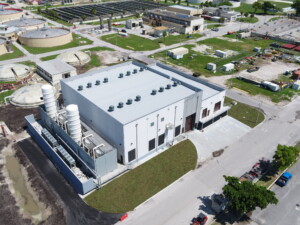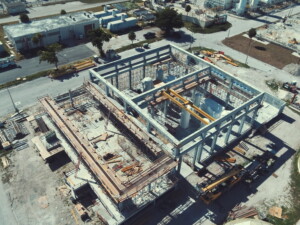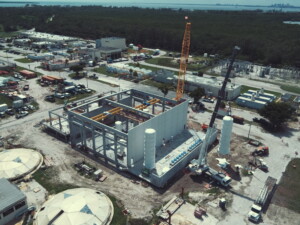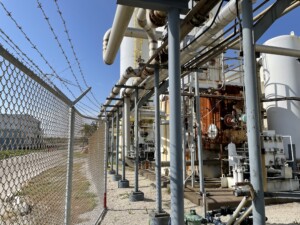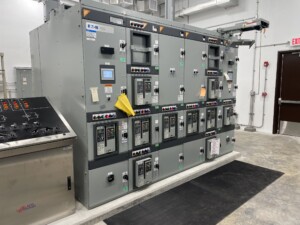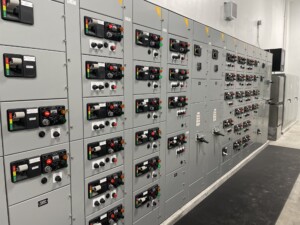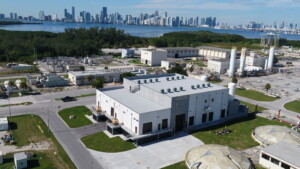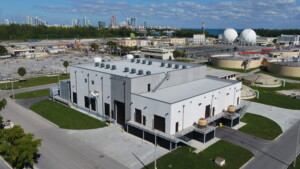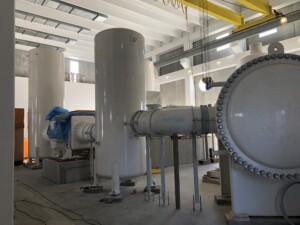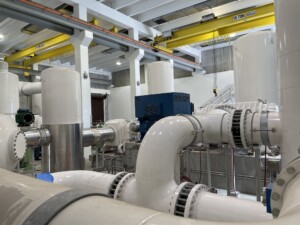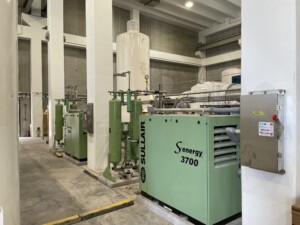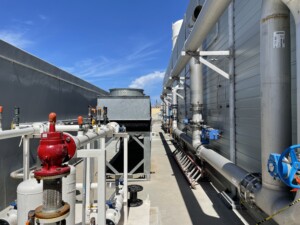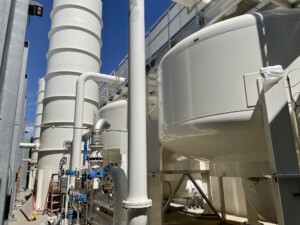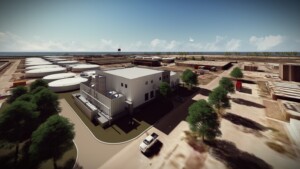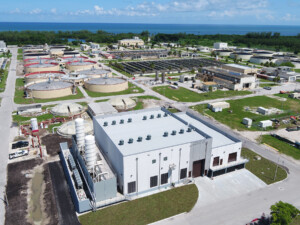Challenge
The Miami-Dade Water and Sewer Department’s (MDWASD) Central District Wastewater Treatment Plant (CDWWTP), one of three plants serving the area, is situated on Virginia Key, just south of one of the most premier areas of Miami. The CDWWTP uses a high-purity oxygen activated sludge (HPOAS) biological treatment process, which requires on-site generation of high-purity oxygen. The oxygen is produced by three cryogenic air separation units which are nearing the end of their useful life at nearly 50 years of age. MDWASD decided to take cryogenic systems 1 and 2 offline but leave the newer cryogenic unit 3 in service, which will allow CDWWTP to continue to produce some liquid oxygen on-site to keep their backup liquid oxygen tanks filled.
The project involved installing vacuum pressure swing adsorption (VPSA) oxygen production units to replace the aging cryogenic oxygen system which will enable Miami-Dade County to meet new environmental guidelines set by the US Environmental Protection Agency (EPA) and the Florida Department of Environmental Protection (FDEP). The newer technology will produce pure oxygen for the plant more efficiently and cost effectively.
Approach
Miami-Dade entered into a federally mandated consent decree with EPA and FDEP, which determined a hard date by which the county was required to have zero ocean outfall from its wastewater collection and treatment system. Since this project was governed by the consent decree, schedule was a concern and the design-build approach offered time savings.
The project included several items of work that were designed as “construction-ready” components to clear the footprint for the new building, which meant PCL could jump right into construction from day one of NTP. However, during the early phase of construction, the team identified several issues with these components which impacted the ability to accommodate future needs. Working together with the construction team, the design team redesigned these components to facilitate easier and more efficient construction, while also accommodating future expansion needs. These modifications to the electrical site plan and yard piping were proposed as a no-cost change to the owner and provided them with better future accommodations as well as easier construction for the team.
Since the overall design of the new plant did not consider all existing infrastructure, nor did it plan for future construction, the existing electrical duct banks were relocated to free up the footprint of the new facility. All subsurface utility elevations were gathered and entered into the 3D BIM model to confirm success of the new plan. The location of the oxygen building was also adjusted to keep all new utilities and manholes in one area, lessening the impact of underground utilities on plant operations and allowing room for future plant expansion.
PCL and Wade Trim collaborated with Stantec, the owner’s engineer, to deliver the project. The team worked with MDWASD, their program manager, and the major equipment suppliers, including Ferguson, to provide extensive value engineering solutions to further align all construction budget, schedule, and compliance goals. Since the cryogenic oxygen system is a 50-year-old technology with outdated motors and other equipment, the new VPSA system was designed around high-efficiency electric motors, which improved power consumption to meet the new efficiency guidelines.
Results
PCL and Wade Trim redesigned the entire project after receiving documents from Stantec, the owner’s engineer. After working with Miami-Dade it was decided that the project needed to be redesigned for future expansion and to expand the life of the facilities. The design-build team developed a plan that would allow the owner to continue to use its existing cryogenic unit 3 for the remainder of its useful life while gaining the energy savings benefit of the VPSA technology. Now the County can easily take cryogenic unit 3 offline when needed. The design-build team revised the building layout to remove costly flood control gates while still protecting the facility from flooding. This was accomplished by raising the building finished floor and providing a lower-level truck bay for removing equipment.
Early involvement of main subcontractors and suppliers, who reviewed and actively participated in design reviews at each design deliverable, captured any cost impacts that could be mitigated by adjusting the design and, at the same time, helped provide a quality product that met the design criteria package. PCL provided “all-in” contracts to suppliers and subcontractors that included their active participation in the workshops and drawing review meetings. Stantec was required to inform the contractor and the rest of the team if any major changes were required where the budget might be impacted. The design-build team held weekly design meetings to discuss and address all the comments from subcontractors, suppliers, the owner, and the owner’s engineer.
The design-build team held coordination meetings at the beginning with the subcontractor and suppliers to outline expectations and held coordination meetings with the owner, the owner representative (CD PMCM), and the owner’s engineer to outline the expectations and critical items that were driving the schedule. Choosing the collaborative delivery model took one to one and a half years off the schedule as compared to the design-bid-build delivery method.
This project was the recipient of the 2022 Merit Award – Wastewater Collection, Treatment, Reuse Facilities from DBIA Florida Region, as well as the 2021 Project of the Year Award from the Cuban American Association of Civil Engineers (CAACE).
Other WCDA member involved: Ferguson Waterworks (supplier of pipes, valves, and fittings)
“PCL and their electrical subcontractor were requested to review the revised contract drawings. Their constructability review and alternate proposal resulted in a product that satisfied the contract requirements and addressed the client’s future needs with no cost or schedule impacts. This is an excellent example of PCL’s attitude and teamwork.”
–Stephen Cross, Consent Decree Program Construction Manager

